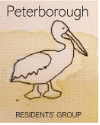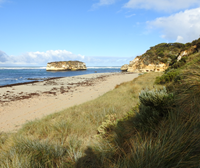Features
- On a calm day this is a perfect spot to relax, because it is more open than some other nearby beaches, it is less frequented.
- The rock formation that intersects the beach has a convenient hole to put your face into and have your photo taken.
- At the end of the beach is the rocky cove called Massacre Bay, see the History below.
- The stunning views make it an excellent spot for photographers.
Note:
- Like all except the main beach, there are no life guards here, so paddling or shallow water play only is suggested.
- Remember to leave only your footsteps.
- Stay within the fences. These fences exist to both protect you from dangers unknown to you and also to protect the flora and fauna from you.
History
I recall the first time I looked on the cliff faces along the Bay of Islands Coastal Park and was told the story of the massacre that occurred. My attention was drawn to the streaks of of red that dribbled down the cliff face, the red clay soils dark against the golden sandstone of the cliffs. My interpreter of local knowledge told me of the rumours that there was a massacre here of the indigenous population and the cliff face is a reminder to us all of the blood that was shed. When I looked at the peaceful water of the Bay of Martyrs, that seemed incredulous to me. The cliffs surrounding this bay were not the like steep cliffs elsewhere. I wanted to find out the truth. Decades later this is what I know.
The local people of this beautiful place were called the Baradh gundidj. Gundidj means group, perhaps we would understand it as clan.
In 1932 a French surveyor named a geographic location as Cape of Martyrs. Today this is a non descript point of land near what we know as the Bay of Islands, further west of the Bay of Martyrs. In 1932, the only white men found in the area were likely to be the whalers, and before them the mutton birders and sealers, who travelled along the coast. They were lawless adventurers who had a history of stealing the indigenous women. As you could expect their presence was not welcome to the Baradh gundidj, it is likely that blood was shed. What happened we don't know, but that didn't sound like a massacre.
October 1843 is the date given for when a group of men walked through Peterborough from Port Fairy en route to Johanna. The event was recorded by the Port Phillip District Superintendent, Charles LaTrobe after he visited Peterborough in 1846, LaTrobe described the men as very loose but no mention was made of the massacre in his Annual Report. One important point to note is that individuals were rushing to the South West Coast with the desire to take up large acreages of land. These men employed others to undertake work on their behalf. As such a man, Neil Black wrote in 1840: "I could not stand the thought of murdering them, and to tell the truth I believe it impossible to take up a new run without doing so". Mr Black had just bought the property now called Glenormiston after the ruthless Taylor massacred the local indigenous people there. Taylor was an employee of the previous owner and yes, he got off scot free. This is how things happened.
So, what happened here? Oral history tells us that the men were forced off the cliffs to the rocks below and the women and children were chased to the swamps and killed there. The place called Massacre Bay is a small rocky cove between the Bay of Martyrs and Crofts Bay. A little bit inland is a placed known as Massacre Hill.
After those Port Fairy men walked through Peterborough, the Baradh gundidj were not seen again. Other clans in the area numbered between 60 to 200, so the number of Baradh massacred would have been significant. This does not mean that there were no survivors, there were always survivors, but they would have fled to other clans for safety and to recover from their experience.
The information contained here is informed by the dedicated and meticulous researcher into the massacre, Ken Clements.


